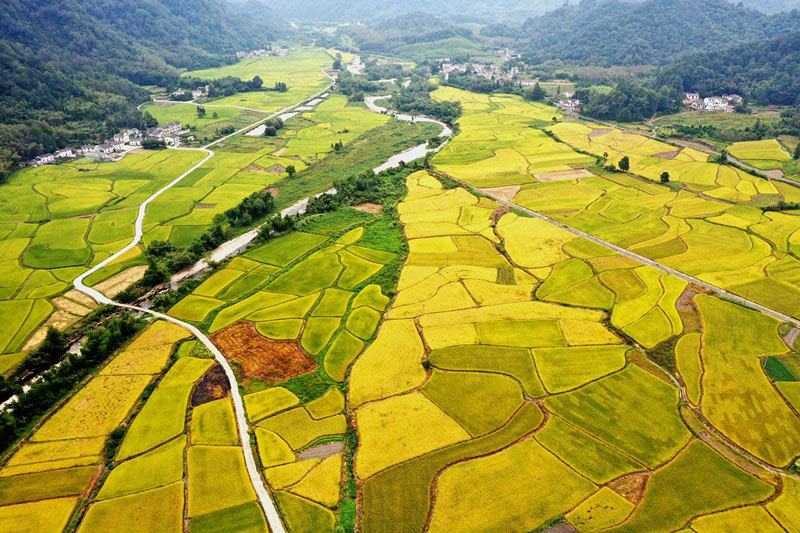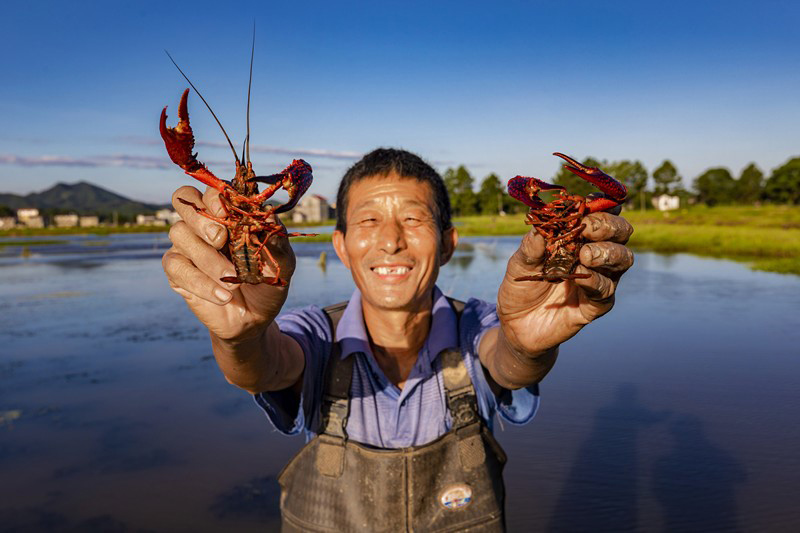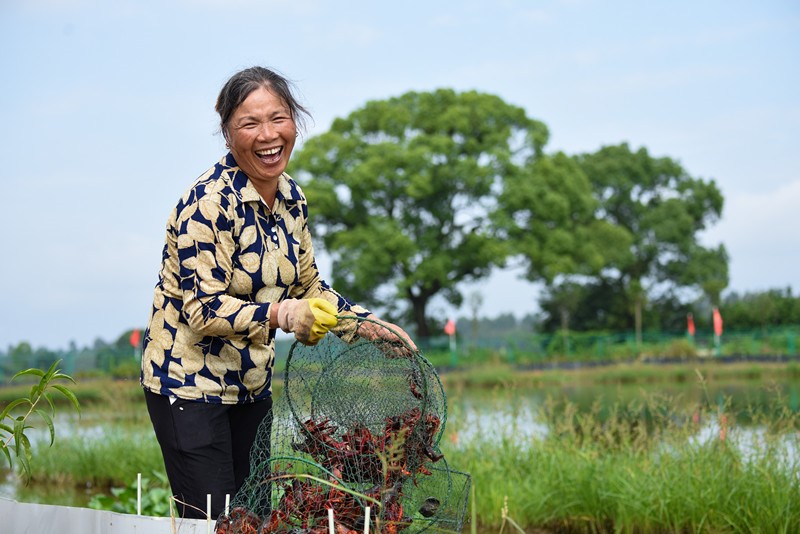

A new round of crayfish season has just started in many rice-crayfish fields in southern China.
In Duchang, Jiangxi, the rice-crayfish farming mode is bringing an net income of 3,000 yuan ($439) per mu (667 square meters) to local farmers. Compared with rice planting, the output of the mixed mode at least doubled. The rice-crayfish farming mode has already become a new path of poverty alleviation for local farmers.

Photo taken on Sept. 9 shows a rice-fish production base in Huangshan district, East China’s Anhui Province embracing a big harvest. Photo by Pan Cheng/People’s Daily Online
China has a long history of fish-farming in rice fields. As early as more than 2,000 years ago, ancient Chinese had already been self-sufficient by planting rice and breeding fish in same fields. As one of the mixed rice-fishing farming mode, rice-crayfish farming is an important method for farmers to increase income, because it not only generates hundreds of kilograms of crayfish every mu, but also improves the quality of rice.
Compared with traditional rice planting, this mode is able to generate win-win results. The rice, which grows with the crayfish, needs no pesticides or fertilizer, and the crayfish in the rice paddies can loosen the soil and kill pests. Besides, the excrement of the crayfish also serves as natural fertilizer.
The rice grown in such a green manner is several times more expensive than traditional ones, and some are even priced at over 20 yuan per kilogram.

A harvester reap rice in a demonstration base of rice-crayfish farming in Huichang county, Ganzhou, East China’s Jiangxi Province, Sept. 4. Photo by Zhu Haipeng/People's Daily
As rent, price of agricultural materials and labor charges rise in recent years, there’s a growth in the cost of crop plating. In a word, the rice-crayfish farming exactly mirrors the adjustment of grain production.
When traditional planting methods are seeing reduced profits and the market demanding more green and quality agricultural products, grain growers must change their farming mode.
Duchang, promoting the mode of rice-crayfish farming, has expanded the income channels for farmers and made the used-to-be low-output fields prosperous. It has achieved favorable results in both ecology and economy. More and more farmers are trying to mix husbandry with rice planting in their paddies.

A farmer shows crayfish he has just captured in Taihai county, Ji’an, East China’s Jiangxi Province on June 17. Photo by Sima Tianmin/People’s Daily Online
The adjustment of agricultural production modes calls for appropriate means that suit local conditions. On one hand, supporting facilities are needed to bring the new modes into full play; on the other hand, adjustment needs to be made according to local climates and resources.
For instance, Anhui Province’s Lujiang is growing milk vetch, a kind of green manure, in rice paddies during winter, which has largely increased the organic content of the soil. Xinan village in Suihua, Heilongjiang Province has built a rice field theme park for both production and tourism.
On the production end, farmers must increase the value added of their products, reduce the usage of fertilizers and pesticides, and stretch the industrial line to promote the supply-side structural reform in the agricultural sector, and realize high-quality, high-profit, and sustainable development of agriculture.

A woman captures crayfish in an ecological plantation base in Wan’an county, Ji’an, East China’s Jiangxi Province on June 6. Photo by Bao Gansheng/People’s Daily Online
The reason for the large promotion of mixed rice-fishing farming is that it not only enriches the side products in the rice fields, but also consolidates the basis for grain production and improves rice quality.
According to experts, crayfish and fish breeding in the rice fields is able to increase the leaf nitrogen content of the rice during tillering and pustulation periods. Besides, it also improves the ear bearing tiller rate of the rice.
In addition, abandoned farmlands are re-exploited in this mode, which effectively expanded the area of grain planting.

 Award-winning photos show poverty reduction achievements in NE China's Jilin province
Award-winning photos show poverty reduction achievements in NE China's Jilin province People dance to greet advent of New Year in Ameiqituo Town, Guizhou
People dance to greet advent of New Year in Ameiqituo Town, Guizhou Fire brigade in Shanghai holds group wedding
Fire brigade in Shanghai holds group wedding Tourists enjoy ice sculptures in Datan Town, north China
Tourists enjoy ice sculptures in Datan Town, north China Sunset scenery of Dayan Pagoda in Xi'an
Sunset scenery of Dayan Pagoda in Xi'an Tourists have fun at scenic spot in Nanlong Town, NW China
Tourists have fun at scenic spot in Nanlong Town, NW China Harbin attracts tourists by making best use of ice in winter
Harbin attracts tourists by making best use of ice in winter In pics: FIS Alpine Ski Women's World Cup Slalom
In pics: FIS Alpine Ski Women's World Cup Slalom Black-necked cranes rest at reservoir in Lhunzhub County, Lhasa
Black-necked cranes rest at reservoir in Lhunzhub County, Lhasa China's FAST telescope will be available to foreign scientists in April
China's FAST telescope will be available to foreign scientists in April